Game Performance Testing
Metro Exodus Enhanced Edition
On May 6th, 2021 developer 4A games released Metro Exodus Enhanced Edition, an update that requires users to have a Ray Tracing compatible video card as a minimum requirement. In this updated title we see 4K resolution textures, Variable Rate Shading, Fully Ray Traced Light Sources, Ray Traced emissive surfaces, Ray Traced area shadows, Ray Traced reflections, and much more. For our performance testing, we will be utilizing the provided benchmark tool included with the game.
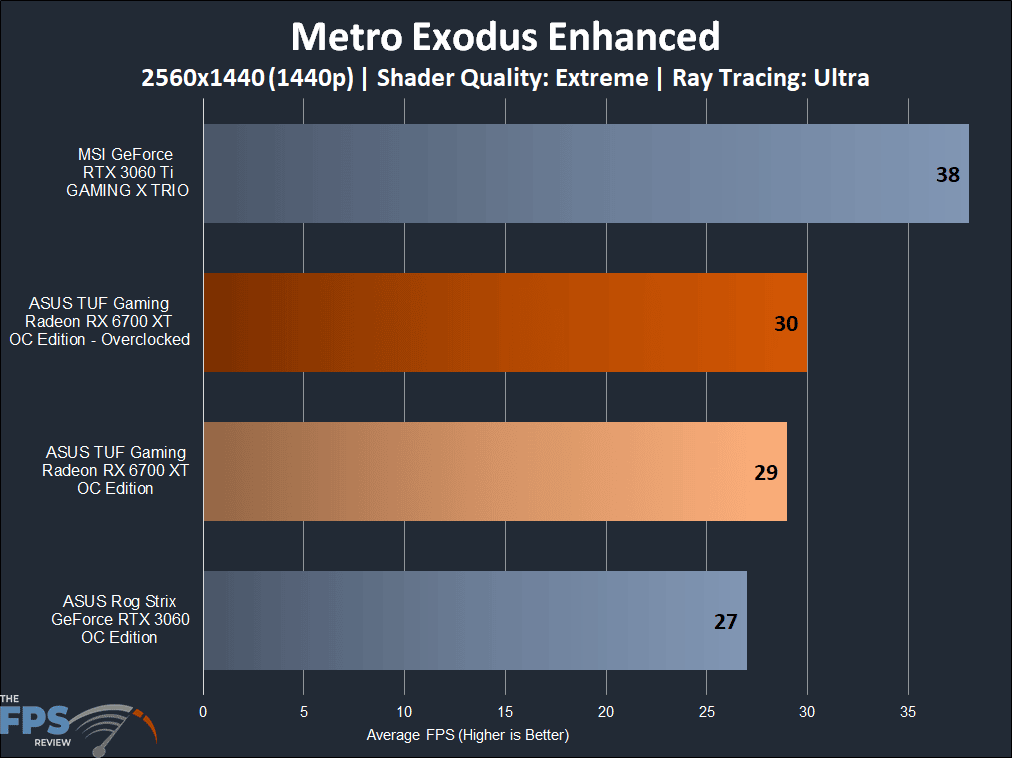
This is one of the more demanding games in our lineup and it shows. Setting the game to 1440P resolution with “Extreme” Quality Shaders and “Ultra” Quality Ray Tracing causes our framerates to tank across the board. As you can see the ASUS TUF Gaming Radeon RX 6700 XT sits in the middle of the pack here managing to squeeze out an average of 29 FPS stock, which’s 26% slower than the MSI RTX 3060 Ti GAMING X TRIO in this test. It’s also only 7% faster than the ASUS ROG STRIX RTX 3060 OC Edition that we used.
Of course, it’s important to remember that this title was optimized with Ray Tracing in mind, and right now Ray Tracing is a weak point of AMD video cards. Overclocking does not manage to improve things much here, as we gain a single extra frame after applying our profile.
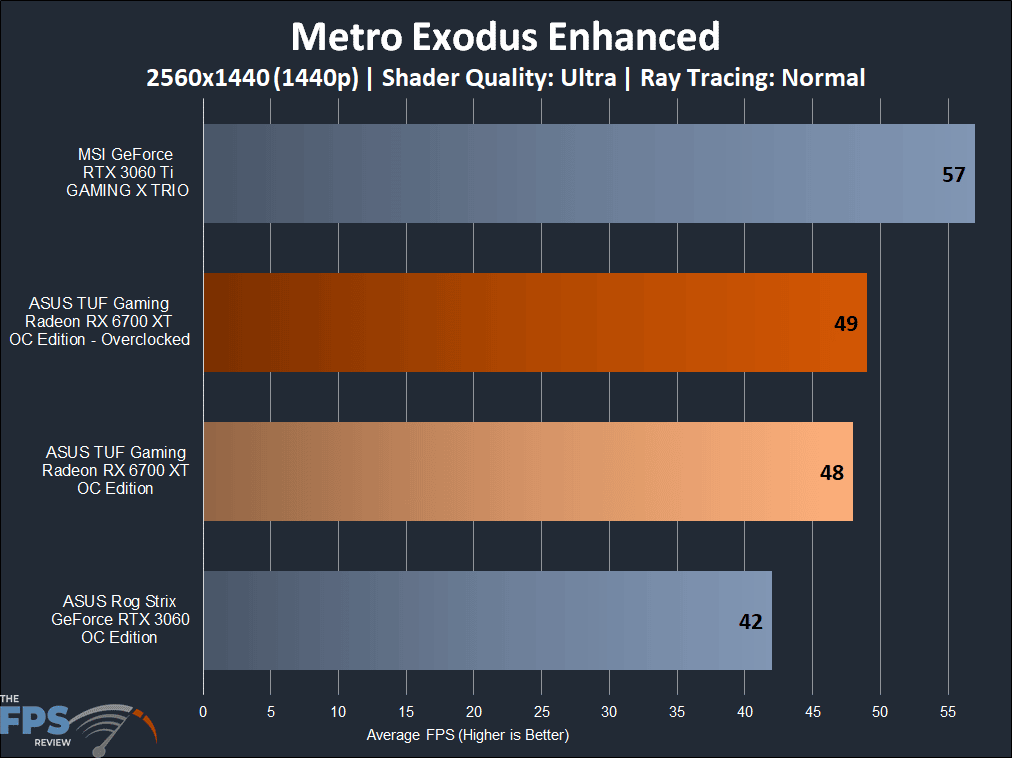
When switching over to “Ultra” Quality Shaders, and “Normal” Quality Ray Tracing at 1440P we manage to obtain a playable gameplay experience on all cards. With our new settings, we are averaging 48 FPS at stock which is more than playable in this title with these quality settings. The gap between our stock performance and the MSI RTX 3060 Ti GAMING X TRIO decreases by a bit down to 17% with the competition reaching an average of 57 FPS to our 48 FPS.
Performance over the ASUS ROG STRIX RTX 3060 OC Edition grows to 13%, equating to an extra 6 FPS on average. Finally with overclocking we gain a subtle +1 FPS increase which amounts to a 2% bump in performance when put side by side with our stock results. This brings the ASUS TUF Gaming Radeon RX 6700 XT within 15% of the MSI RTX 3060 Ti GAMING X TRIO and 15% ahead of the ASUS ROG STRIX RTX 3060 OC Edition.
Cyberpunk 2077
Cyberpunk 2077 is a part of our test suite and for good reason. Atop of being one of the biggest game releases of late, it’s also one graphically intensive title. In Cyberpunk 2077, we are using patch version 1.2 of the game, the “Ultra” quality preset without modifications. We are utilizing a custom driving course at night and averaging our results after multiple runs.
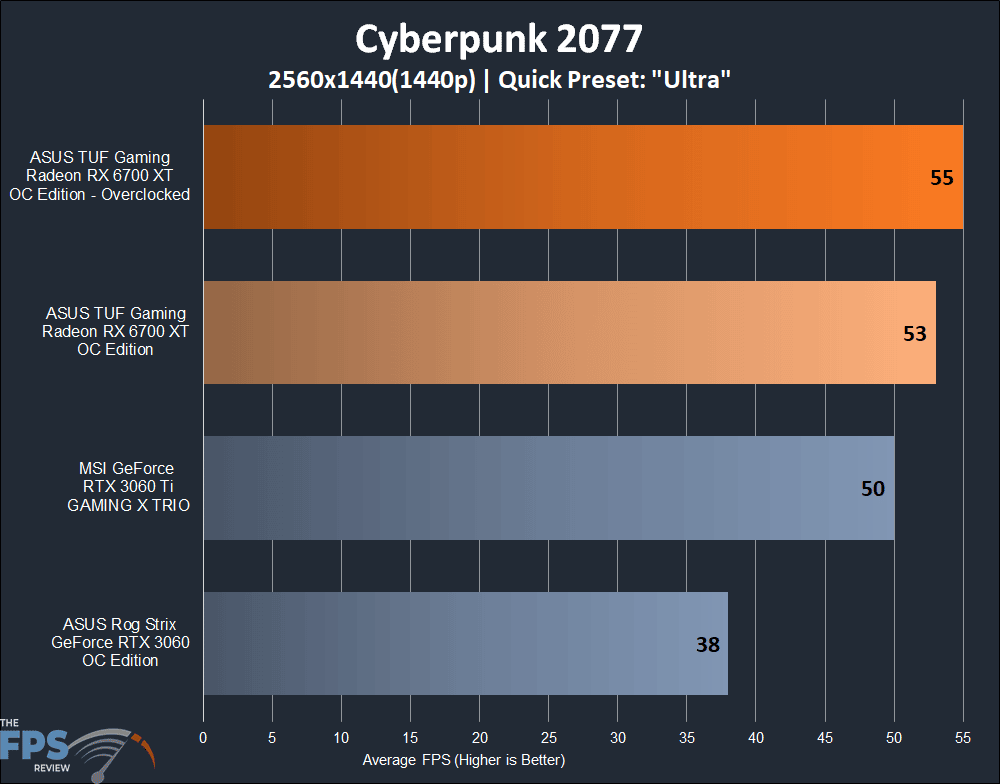
At 1440P with no Ray Tracing enabled we are witnessing a slight victory here for the ASUS TUF Gaming Radeon RX 6700 XT over the MSI RTX 3060 Ti GAMING X TRIO. At their stock settings, the ASUS TUF Gaming Radeon RX 6700 XT card manages to push out 53 FPS average compared to the 50 FPS average for the MSI RTX 3060 Ti GAMING X TRIO. This is roughly a 6% performance advantage in favor of the Radeon card. Both of these cards blow well past the ASUS ROG STRIX RTX 3060 OC Edition which averaged 38 FPS. This is a 33% difference but it’s well within expectations given the comparison.
Once we get to manual overclocking we see an uptick of about 4% for our ASUS TUF Gaming Radeon RX 6700 XT. This results in an average of 55 FPS, or 10% faster than the MSI RTX 3060 Ti GAMING X TRIO and 37% faster than the ASUS ROG STRIX RTX 3060 OC Edition. All in all Cyberpunk 2077 runs well on Radeon cards when utilizing a rasterization-based rendering method.
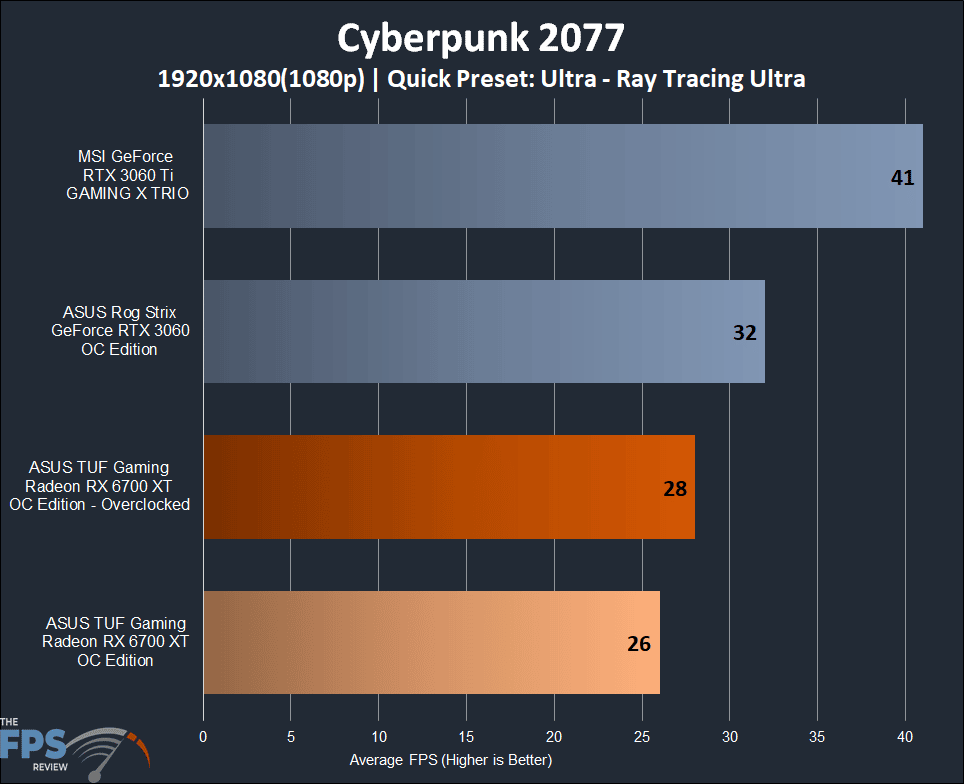
Switching over to Ray Traced performance ends up with us quickly finding that “Ultra” quality Ray Tracing is simply not obtainable at 1440P with this video card. Framerates were in the upper teens and the experience was more akin to a slideshow than a smoothly rendered graphic image. As a result, we found ourselves switching over to the “Medium” Ray Tracing preset for performance testing.
The graph is fairly self-explanatory here, with our stock and overclocked ASUS TUF Gaming Radeon RX 6700 XT rounding out the bottom with ray tracing enabled. Our stock performance here is abysmally low at 22 FPS average, increasing to 24 FPS average (+8%) with our overclocked profile applied. This means that our overclocked performance is actually 4% lower than that of the ASUS ROG STRIX RTX 3060 OC Edition and 25% slower than the MSI RTX 3060 Ti GAMING X TRIO. It’s safe to say that you will want to drop the settings down further to enjoy this game with RT at 1080p with the ASUS TUF Gaming Radeon RX 6700 XT.
Dirt 5
This is a relatively new addition to our benchmark suite and it’s a somewhat recent release as well, having come out November 6th, 2020. As the name suggests this game is an off-road racing game. Dirt 5 is a Codemasters title with Ray Tracing and some impressive visuals.

With ray tracing disabled we set off to bench this game at 1440p resolution with maxed out settings and dynamic resolution scaling disabled. In this scenario, the ASUS TUF Gaming Radeon RX 6700 XT went to town producing framerate averages of 89 FPS when left at stock. This is about 3.4% faster than the MSI RTX 3060 Ti GAMING X TRIO which ended up churning out an 86 FPS average.
We see the ASUS TUF Gaming Radeon RX 6700 XT coming in 28% faster than the ASUS ROG STRIX RTX 3060 OC Edition’s 67 FPS average. With a slight overclock we gained a small boost of 4.3% which resulted in a 94 FPS average. This widens the gap between our review card and the MSI RTX 3060 Ti GAMING X TRIO to 7.8%, and further distances itself from the ASUS ROG STRIX RTX 3060 OC Edition by coming in 32.5% faster.
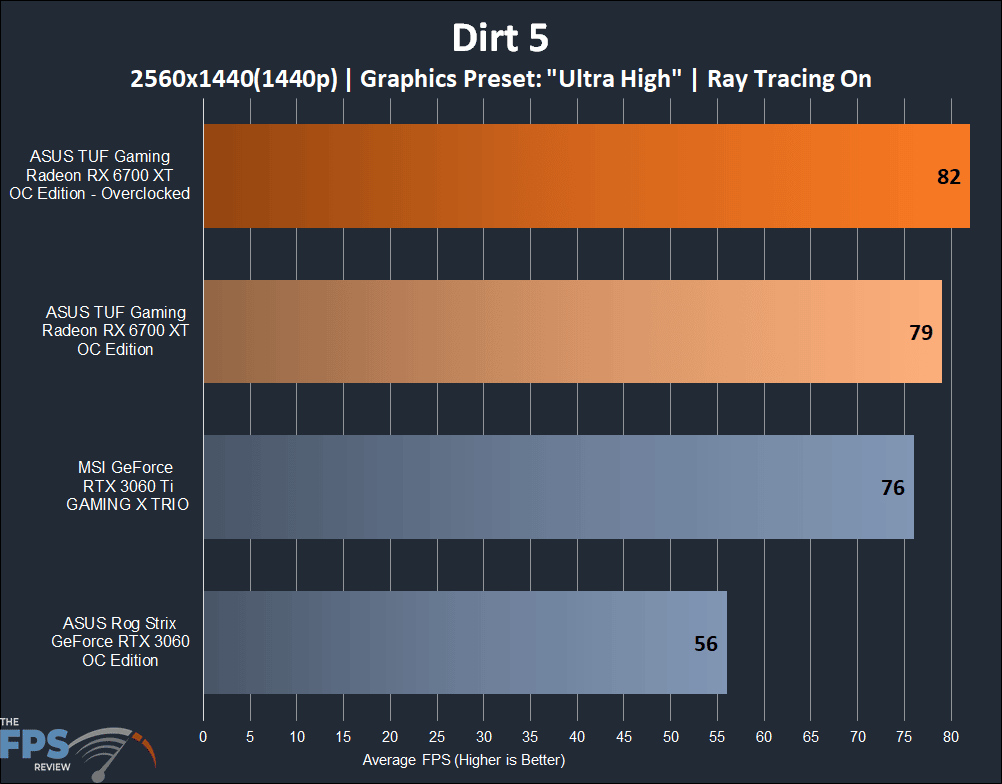
We flipped on the ray-tracing setting in this game to see what might change given NVIDIA’s maturity in this area. To our surprise, the standings remained the same, with AMD leading the pack in both stock and overclocked scenarios. The performance gap between the MSI RTX 3060 Ti GAMING X TRIO and our review card was reduced somewhat, with our ASUS TUF Gaming Radeon RX 6700 XT staying about 3.8% faster at stock, 79 FPS average compared to 76 FPS average.
The ASUS ROG STRIX RTX 3060 OC Edition ended up with a 56 FPS average or about 16% behind the ASUS TUF Gaming Radeon RX 6700 XT’s 79 FPS average. Overclocking gained us roughly 4% more performance, pushing our average up to 82FPS from 79 FPS. This results in our ASUS TUF Gaming Radeon RX 6700 XT maintaining a 7.5% lead over the MSI RTX 3060 Ti GAMING X TRIO and a 37% performance advantage over the ASUS ROG STRIX RTX 3060 OC Edition.
This really does show that the ray tracing implementation can vary from title to title considering how well the ASUS TUF Gaming Radeon RX 6700 XT performs here.
